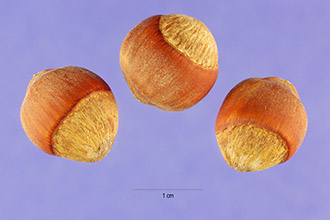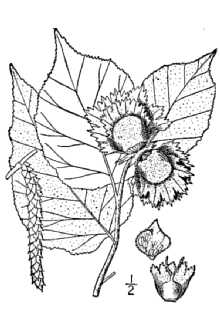American Hazelnut
Scientific Name: Corylus americana Walter

| General Information | |
|---|---|
| Usda Symbol | COAM3 |
| Group | Dicot |
| Life Cycle | Perennial |
| Growth Habits | Shrub |
| Native Locations | COAM3 |
Plant Guide
Uses
Hazelnuts and filberts are produced by species of Corylus. Commercial filberts (C. colurna L. and C. maxima Mill.) are cultivated in various parts of the world, particularly Turkey, Italy, Spain, China, and the US. Nuts of the two native American species (C. americana and C. cornuta) are smaller but similar to the cultivated ones in flavor, and C. cornuta also is commercially cultivated for nut production. The nuts of both species are sweet and may be eaten raw or ground into flour for cake-like bread. The nuts were used by American Indians to flavor soups. The nuts of American hazelnut, which have a higher nutritional value than acorns and beechnuts, also are eaten by squirrels, foxes, deer, northern bobwhite, ruffed grouse, turkey, woodpeckers, pheasants, and deer. The leaves, twigs, and catkins are browsed by rabbits, deer, and moose. The male catkins are a winter food for turkey and ruffed grouse. The dense, low growth habit provides cover and nesting sites for many wildlife species. Extractives of American hazelnut and their physically modified derivatives, primarily glycerides of the fatty acids, are used for emollients. Other derivatives, such as tinctures, concretes, absolutes, essential oils, oleoresins, terpenes, terpene-free fractions, distillates, and residues are used for botanicals. American hazelnut has long been valued as an ornamental and for planting in naturalized settings. It grows in sun or partial shade and is useful for borders because of its colonial tendency. The leaves turn orange to red or purple in the fall. It is available from various commercial growers – there apparently are no cultivars apart from the wild type. Cultivars of the European filbert (C. avellana L.) tend to be small trees and also are useful in landscaping. © William S. Justice Dept. of Botany, Smithsonian Institution @ PLANTS
Status
Please consult the PLANTS Web site and your State Department of Natural Resources for this plant’s current status, such as, state noxious status and wetland indicator values.
Description
General: Birch family (Betulaceae). Native shrubs growing 1-3(-4) meters tall, strongly rhizomatous and forming colonial thickets; main stems (or trunk) straight, with spreading, ascending branches, the twigs slender, zigzag, light brown, with numerous stiff, red-glandular hairs. Leaves are deciduous, alternate, broadly oval with a heart-shaped or rounded base, 8-12(-15) cm long and 12 cm wide, acuminate, doubly serrate, hairy beneath, the petiole with stiff, glandular hairs. Male (staminate) and female (pistillate) flowers are separate, but both types present on each plant (the species monoecious); male flowers numerous in long, pendulous stalks (catkins) 8-10 cm long, in clusters of two or three near branch tips, appearing in the fall, but opening the following spring. Female flowers are several in a scaly bud, tiny and inconspicuous with only bright red stigma and styles protruding from the gray-brown buds, almost completely enclosed by bracts, near the end of the twigs. Fruit is a light brown, acorn-like nut 1-2 cm long, wider than long, enclosed in two, leafy, coarsely toothed (husk-like) bracts. The common name reflects its being native to North America and “hazel” is from the Old English name for filbert. Variation within the species: several variants have been described within the species: Corylus americana var. indehiscens Palmer & Steyermark (fruit bracts united along one side) from southwestern Missouri; Corylus americana forma missouriensis (A. DC.) Fern. (petioles essentially glandless) from southeastern Kansas. These have not been generally recognized, and the species is currently treated with no formal variants. Distinguished from beaked hazelnut (Corylus cornuta) by absence of a horned beak on the fruit. Distribution: Widespread in eastern North America, Maine west to Saskatchewan and North Dakota, south to eastern Oklahoma, Arkansas, and Georgia, not found along the Gulf coast region. For current distribution, please consult the Plant Profile page for this species on the PLANTS Web site.
Adaptation
American hazelnut occurs in moist to dry woods and thickets, forest margins, roadsides, and fencerows and other disturbed areas. It grows best on rich, moist, well-drained soils but often may be found close to streamsides and also grows on prairies. Open habitats are common, but it also can grow successfully in deep shade and is found at 0-750 at meters in elevation. This species flowers in March–May before the emergence of leaves and fruits in July–September.
Establishment
Plants of American hazelnut may begin producing seed after the first year and produce good seed crops every 2-3 years, The seeds have a period of dormancy, apparently overcome by cold treatment, , Use soil moisture sensors to measure the soil moisture of American Hazelnut.
Management
American hazelnut is removed by growers of commercial, closely managed forests, primarily because of its aggressive colonial habit and corresponding competition with timber trees. It is easily top-killed by spring and summer fires. The underground roots and rhizomes can survive low- to moderate-severity fires when the humus is moist, but they are relatively shallow and vulnerable to repeated summer fires when the humus is dry and combustible. American hazelnut is not affected by any serious pests. Several canker-forming fungi may result in girdling or breakage of stems. Mildew may defoliate plants and fungi may destroy nuts. Cultivars, Improved and Selected Materials (and area of origin) Sun Harvest Germplasm American hazelnut was released from the Elsberry Plant Materials Center in 2007. Sun Harvest Germplasm is a composite of six accessions that were collected in Illinois and Missouri. The 6 accessions that comprise Sun Harvest Germplasm were selected from a total of 14 accessions for greater canopy symmetry, plant height, nut production and insect/disease resistance. Sun Harvest Germplasm provides excellent wildlife food and habit. Also, it may be useful as a medium sized tree component in windbreaks. Contact your local Natural Resources
Conservation
Service (formerly Soil Conservation Service) office for more information. Look in the phone book under ”United States Government.” The Natural Resources Conservation Service will be listed under the subheading “Department of Agriculture.”
References
Brunner, F. & D.E. Fairbrothers 1979. Serological investigation of the Corylaceae. Bull. Torrey Bot. Club 106:97-103. Buckman, R.E. 1964. Effects of prescribed burning on hazel in Minnesota. Ecology 45:626-629. Coladonato, M. 1993. Corylus americana. IN: W.C. Fischer (compiler). The fire effects information system [Data base]. USDA, Forest Service, Intermountain Research Station, Intermountain Fire Sciences Laboratory, Missoula, Montana. <http://www.fs.fed.us/database/feis/> Drumke, J.S. 1965. A systematic survey of Corylus in North America. Diss. Abstr. 25:4925-4926. Furlow, J.J. 1990. The genera of Betulaceae in the southeastern United States. J. Arnold Arbor. 71:1-67. Furlow, J.J. 1993. Corylus. Pp. 535-538, IN: Flora of North America, north of Mexico. Vol. 3. Oxford Univ. Press, New York, New York. <http://hua.huh.harvard.edu/cgi-bin/Flora/flora.pl?FLORA_ID=12395> Hardin, J.W. 1952. The Juglandaceae and Corylaceae of Tennessee. Castanea 17:78-89. Kasapligil, B. 1964. A contribution to the histotaxonomy of Corylus (Betulaceae). Adansonia 4:43-90. Kasapligil, B. 1972. A bibliography on Corylus (Betulaceae) with annotations. Northern Nut Growers Ann. Rept. 63:107-162.
Plant Traits
Growth Requirements
| Temperature, Minimum (°F) | -33 |
|---|---|
| Adapted to Coarse Textured Soils | No |
| Adapted to Fine Textured Soils | Yes |
| Adapted to Medium Textured Soils | Yes |
| Anaerobic Tolerance | None |
| CaCO3 Tolerance | Medium |
| Cold Stratification Required | Yes |
| Drought Tolerance | Medium |
| Fertility Requirement | Medium |
| Fire Tolerance | Medium |
| Frost Free Days, Minimum | 100 |
| Hedge Tolerance | Low |
| Moisture Use | Medium |
| pH, Maximum | 7.0 |
| pH, Minimum | 5.0 |
| Planting Density per Acre, Maxim | 1700 |
| Planting Density per Acre, Minim | 700 |
| Precipitation, Maximum | 60 |
| Precipitation, Minimum | 32 |
| Root Depth, Minimum (inches) | 20 |
| Salinity Tolerance | None |
| Shade Tolerance | Intermediate |
Morphology/Physiology
| Bloat | None |
|---|---|
| Toxicity | None |
| Resprout Ability | No |
| Shape and Orientation | Erect |
| Active Growth Period | Spring and Summer |
| C:N Ratio | High |
| Coppice Potential | No |
| Fall Conspicuous | No |
| Fire Resistant | No |
| Flower Color | White |
| Flower Conspicuous | No |
| Foliage Color | Green |
| Foliage Porosity Summer | Moderate |
| Foliage Porosity Winter | Porous |
| Foliage Texture | Coarse |
| Fruit/Seed Conspicuous | Yes |
| Nitrogen Fixation | None |
| Low Growing Grass | No |
| Lifespan | Short |
| Leaf Retention | No |
| Known Allelopath | No |
| Height, Mature (feet) | 10.0 |
| Height at 20 Years, Maximum (fee | 10 |
| Growth Rate | Moderate |
| Growth Form | Multiple Stem |
| Fruit/Seed Color | Brown |
Reproduction
| Vegetative Spread Rate | None |
|---|---|
| Small Grain | No |
| Seedling Vigor | High |
| Seed Spread Rate | Slow |
| Fruit/Seed Period End | Fall |
| Seed per Pound | 491 |
| Propagated by Tubers | No |
| Propagated by Sprigs | No |
| Propagated by Sod | No |
| Propagated by Seed | Yes |
| Propagated by Corm | No |
| Propagated by Container | Yes |
| Propagated by Bulb | No |
| Propagated by Bare Root | Yes |
| Fruit/Seed Persistence | No |
| Fruit/Seed Period Begin | Summer |
| Fruit/Seed Abundance | Low |
| Commercial Availability | Routinely Available |
| Bloom Period | Spring |
| Propagated by Cuttings | No |
Suitability/Use
| Veneer Product | No |
|---|---|
| Pulpwood Product | No |
| Post Product | No |
| Palatable Human | No |
| Palatable Graze Animal | Low |
| Palatable Browse Animal | Medium |
| Nursery Stock Product | Yes |
| Naval Store Product | No |
| Lumber Product | No |
| Fodder Product | No |
| Christmas Tree Product | No |
| Berry/Nut/Seed Product | Yes |

